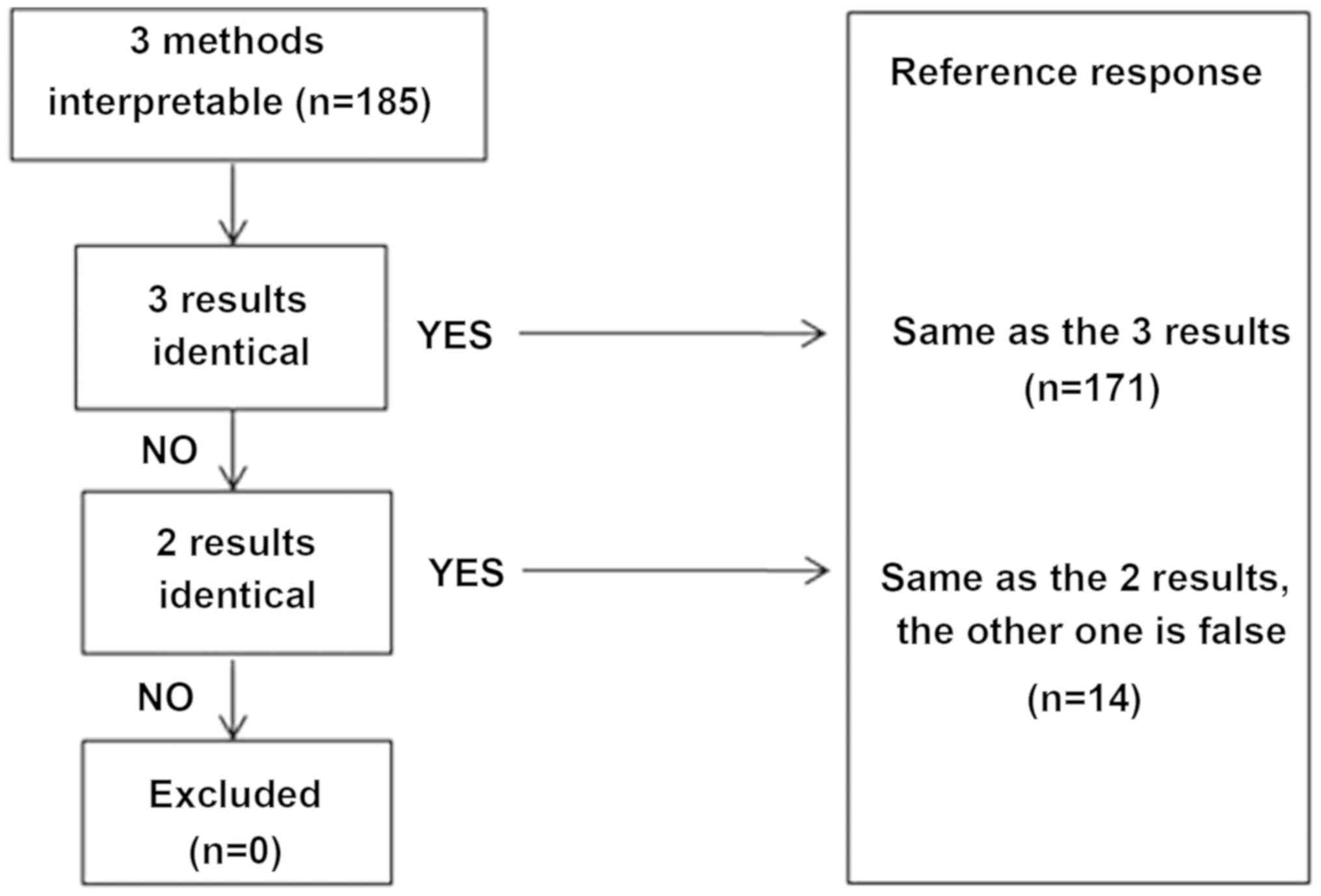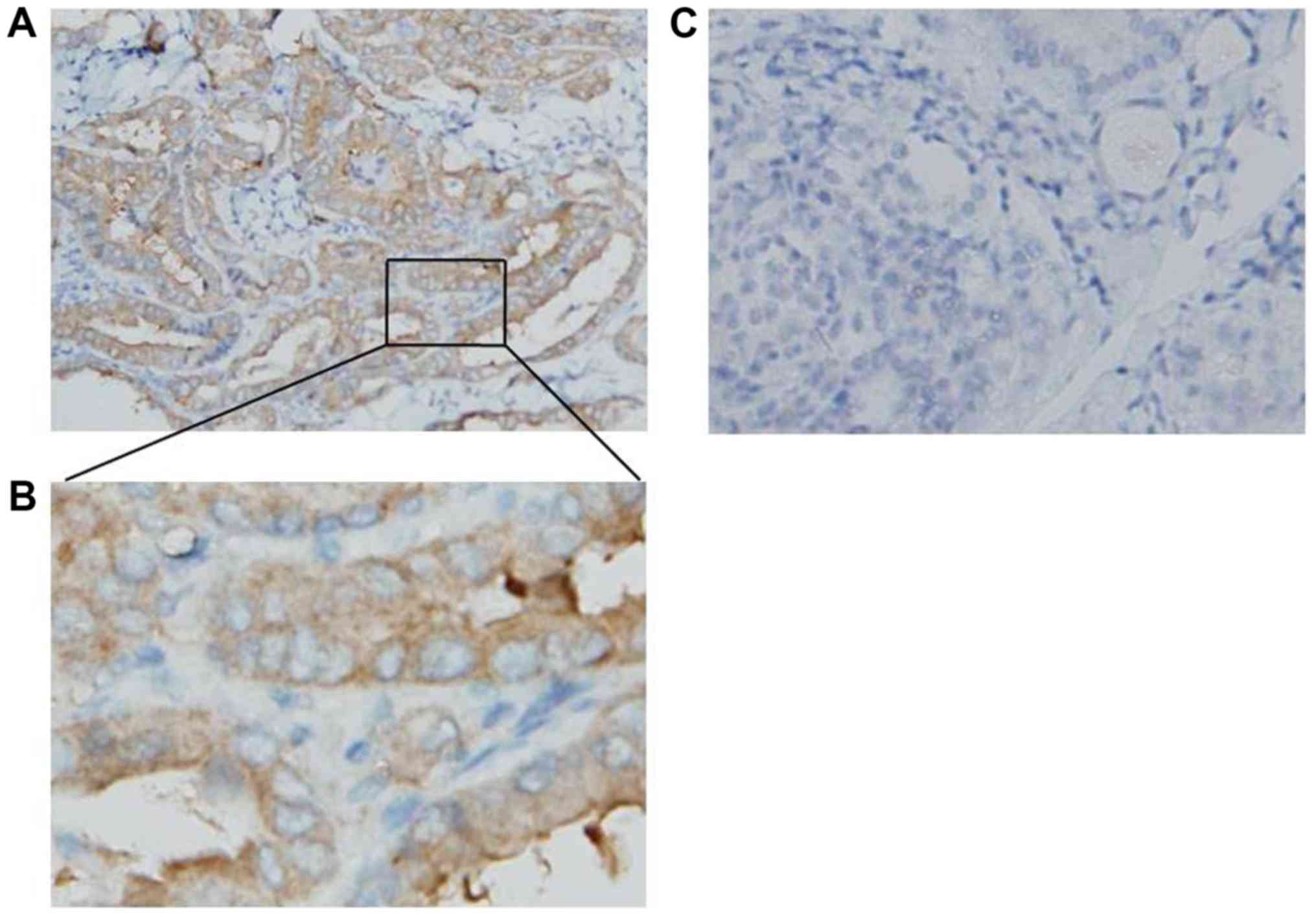|
1
|
Lim H, Devesa SS, Sosa JA, Check D and
Kitahara CM: Trends in thyroid cancer incidence and mortality in
the United States, 1974–2013. JAMA. 317:1338–1348. 2017. View Article : Google Scholar : PubMed/NCBI
|
|
2
|
Xing M, Alzahrani AS, Carson KA, Shong YK,
Kim TY, Viola D, Elisei R, Bendlová B, Yip L, Mian C, et al:
Association between BRAFV600E mutation and recurrence of
papillary thyroid cancer. J Clin Oncol. 33:42–50. 2015. View Article : Google Scholar : PubMed/NCBI
|
|
3
|
American Thyroid Association (ATA)
Guidelines Taskforce on Thyroid Nodules and Differentiated Thyroid
Cancer, ; Cooper DS, Doherty GM, Haugen BR, Kloos RT, Lee SL,
Mandel SJ, Mazzaferri EL, McIver B, Pacini F, et al: Revised
American thyroid Association management guidelines for patients
with thyroid nodules and differentiated thyroid cancer. Thyroid.
19:1167–1214. 2009. View Article : Google Scholar : PubMed/NCBI
|
|
4
|
Xing M: BRAF mutation in thyroid
cancer. Endocr Relat Cancer. 12:245–262. 2005. View Article : Google Scholar : PubMed/NCBI
|
|
5
|
Tufano RP, Teixeira GV, Bishop J, Carson
KA and Xing M: BRAF mutation in papillary thyroid cancer and its
value in tailoring initial treatment: A systematic review and
meta-analysis. Medicine. 91:274–286. 2012. View Article : Google Scholar : PubMed/NCBI
|
|
6
|
Di Benedetto G: Thyroid fine-needle
aspiration: The relevance of BRAF mutation testing. Endocrine.
47:351–353. 2014. View Article : Google Scholar : PubMed/NCBI
|
|
7
|
Xing M: BRAF mutation in papillary thyroid
cancer: Pathogenic role, molecular bases, and clinical
implications. Endocr Rev. 8:742–762. 2007. View Article : Google Scholar
|
|
8
|
Kim TH, Park YJ, Lim JA, Ahn HY, Lee EK,
Lee YJ, Kim KW, Hahn SK, Youn YK, Kim KH, et al: The association of
the BRAFV600E mutation with prognostic factors
and poor clinical outcome in papillary thyroid cancer: A
meta-analysis. Cancer. 118:1764–1773. 2012. View Article : Google Scholar : PubMed/NCBI
|
|
9
|
Nikiforova MN, Wald AI, Roy S, Durso MB
and Nikiforov YE: Targeted next-generation sequencing panel
(ThyroSeq) for detection of mutations in thyroid cancer. J Clin
Endocrinol Metab. 98:E1852–E1860. 2013. View Article : Google Scholar : PubMed/NCBI
|
|
10
|
Xing M, Tufano RP, Tufaro AP, Basaria S,
Ewertz M, Rosenbaum E, Byrne PJ, Wang J, Sidransky D and Ladenson
PW: Detection of BRAF mutation on fine needle aspiration
biopsy specimens: A new diagnostic tool for papillary thyroid
cancer. J Clin Endocrinol Metab. 89:2867–2872. 2004. View Article : Google Scholar : PubMed/NCBI
|
|
11
|
Spittle C, Ward MR, Nathanson KL, Gimotty
PA, Rappaport E, Brose MS, Medina A, Letrero R, Herlyn M and
Edwards RH: Application of a BRAF pyrosequencing assay for
mutation detection and copy number analysis in malignant melanoma.
J Mol Diagn. 9:464–471. 2007. View Article : Google Scholar : PubMed/NCBI
|
|
12
|
Thomas RK, Baker AC, Debiasi RM, Winckler
W, Laframboise T, Lin WM, Wang M, Feng W, Zander T, MacConaill L,
et al: High-throughput oncogene mutation profiling in human cancer.
Nat Genet. 39:347–351. 2007. View
Article : Google Scholar : PubMed/NCBI
|
|
13
|
Pichler M, Balic M, Stadelmeyer E, Ausch
C, Wild M, Guelly C, Bauernhofer T, Samonigg H, Hoefler G and
Dandachi N: Evaluation of high-resolution melting analysis as a
diagnostic tool to detect the BRAF V600E mutation in
colorectal tumors. J Mol Diagn. 11:140–147. 2009. View Article : Google Scholar : PubMed/NCBI
|
|
14
|
Jarry A, Masson D, Cassagnau E, Parois S,
Laboisse C and Denis MG: Real-time allele-specific amplification
for sensitive detection of the BRAF mutation V600E. Mol Cell
Probes. 18:349–352. 2004. View Article : Google Scholar : PubMed/NCBI
|
|
15
|
Anderson S, Bloom KJ, Vallera DU,
Rueschoff J, Meldrum C, Schilling R, Kovach B, Lee JR, Ochoa P,
Langland R, et al: Multisite analytic performance studies of a
real-time polymerase chain reaction assay for the detection of
BRAF V600E mutations in formalin-fixed paraffin-embedded
tissue specimens of malignant melanoma. Arch Pathol Lab Med.
136:1385–1391. 2012. View Article : Google Scholar : PubMed/NCBI
|
|
16
|
Koperek O, Kornauth C, Capper D, Berghoff
AS, Asari R, Niederle B, von Deimling A, Birner P and Preusser M:
Immunohistochemical detection of the BRAF V600E mutated protein in
papillary thyroid carcinoma. Am J Surg Pathol. 36:844–850. 2012.
View Article : Google Scholar : PubMed/NCBI
|
|
17
|
Qiu T, Lu H, Guo L, Huang W, Ling Y, Shan
L, Li W, Ying J and Lv N: Detection of BRAF mutation in Chinese
tumor patients using a highly sensitive antibody
immunohistochemistry assay. Sci Rep. 5:92112015. View Article : Google Scholar : PubMed/NCBI
|
|
18
|
Ihle MA, Fassunke J, König K, Grünewald I,
Schlaak M, Kreuzberg N, Tietze L, Schildhaus HU, Büttner R and
Merkelbach-Bruse S: Comparison of high resolution melting analysis,
pyrosequencing, next generation sequencing and immunohistochemistry
to conventional Sanger sequencing for the detection of p.V600E and
non-p.V600E BRAF mutations. BMC Cancer. 14:132014.
View Article : Google Scholar : PubMed/NCBI
|
|
19
|
Colomba E, Hélias-Rodzewicz Z, Von
Deimling A, Marin C, Terrones N, Pechaud D, Surel S, Côté JF,
Peschaud F, Capper D, et al: Detection of BRAF p.V600E
mutations in melanomas: Comparison of four methods argues for
sequential use of immunohistochemistry and pyrosequencing. J Mol
Diagn. 15:94–100. 2013. View Article : Google Scholar : PubMed/NCBI
|
|
20
|
Sarne DH: A piece of the puzzle: What does
BRAF status mean in the management of patients with papillary
thyroid carcinoma? J Clin Endocrinol Metab. 97:3094–3096. 2012.
View Article : Google Scholar : PubMed/NCBI
|
|
21
|
Handkiewicz-Junak D, Czarniecka A and
Jarzab B: Molecular prognostic markers in papillary and follicular
thyroid cancer: Current status and future directions. Mol Cell
Endocrinol. 322:8–28. 2010. View Article : Google Scholar : PubMed/NCBI
|
|
22
|
Puxeddu E and Filetti S: BRAF mutation
assessment in papillary thyroid cancer: Are we ready to use it in
clinical practice? Endocrine. 45:341–343. 2014. View Article : Google Scholar : PubMed/NCBI
|
|
23
|
Xing M, Haugen BR and Schlumberger M:
Progress in molecular-based management of differentiated thyroid
cancer. Lancet. 381:1058–1069. 2013. View Article : Google Scholar : PubMed/NCBI
|
|
24
|
Tallini G, de Biase D, Durante C,
Acquaviva G, Bisceglia M, Bruno R, Bacchi Reggiani ML, Casadei GP,
Costante G, Cremonini N, et al: BRAF V600E and risk
stratification of thyroid microcarcinoma: A multicenter
pathological and clinical study. Mod Pathol. 28:1343–1359. 2015.
View Article : Google Scholar : PubMed/NCBI
|
|
25
|
Zhang Q, Liu SZ, Zhang Q, Guan YX, Chen QJ
and Zhu QY: Meta-analyses of association between
BRAFV600E mutation and clinicopathological
features of papillary thyroid carcinoma. Cell Physiol Biochem.
38:763–776. 2016. View Article : Google Scholar : PubMed/NCBI
|
|
26
|
Zhang H, Zheng X, Ji T, Fu L, Bai D, Liao
Y, Zhang H, Ding Y and Zheng L: Comparative screening of K-ras
mutations in colorectal cancer and lung cancer patients using a
novel real-time PCR with ADx-K-ras Kit and Sanger DNA sequencing.
Cell Biochem Biophys. 62:415–420. 2012. View Article : Google Scholar : PubMed/NCBI
|
|
27
|
Spagnolo F, Ghiorzo P and Queirolo P:
Overcoming resistance to BRAF inhibition in BRAF-mutated metastatic
melanoma. Oncotarget. 5:10206–10221. 2014. View Article : Google Scholar : PubMed/NCBI
|
|
28
|
Heinzerling L, Kühnapfel S, Meckbach D,
Baiter M, Kaempgen E, Keikavoussi P, Schuler G, Agaimy A, Bauer J,
Hartmann A, et al: Rare BRAF mutations in melanoma patients:
Implications for molecular testing in clinical practice. Br J
Cancer. 108:2164–2171. 2013. View Article : Google Scholar : PubMed/NCBI
|
|
29
|
Lopez-Rios F, Angulo B, Gomez B, Mair D,
Martinez R, Conde E, Shieh F, Vaks J, Langland R, Lawrence HJ and
de Castro DG: Comparison of testing methods for the detection of
BRAF V600E mutations in malignant melanoma: Pre-approval validation
study of the companion diagnostic test for vemurafenib. PLoS One.
8:e537332013. View Article : Google Scholar : PubMed/NCBI
|











